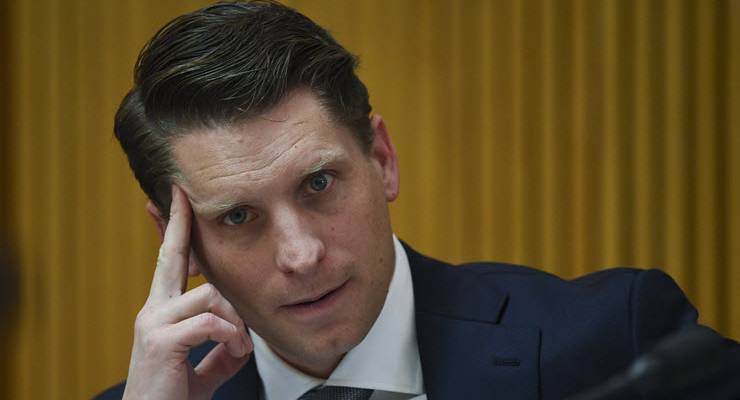
In a government addicted to secrecy, federal MP and former Special Air Service (SAS) officer Andrew Hastie has this week emerged as an unlikely advocate for transparency.
Reflecting on what went wrong in Afghanistan, where SAS soldiers allegedly murdered innocent civilians by the dozen, Hastie concluded that sanitised media reporting, guided by “legions of public affairs officers”, were a big part of the problem.
But will Hastie’s road to Damascus conversion cut any ice?
As Hastie agonised about the secret deeds of his elite brothers documented in the Brereton report and lamented the stifling of public interest reporting, over at the Lodge his boss Scott Morrison was in the midst of a “ScoMo in lockdown” photoshoot with a series of “at home” snaps taken, Kim Jong-un-style, by his personal staff photographer, destined for the pages of News Corp’s Sunday Telegraph.
And then there’s the army’s top brass itself.
Chief of the army Angus Campbell has long been subject to media rules of engagement set by the government, first as major general in charge of Afghanistan operations and later as then-immigration minister Morrison’s right hand man in overseeing Operation Sovereign Borders, the government’s militarised and secretive operation to halt the arrival of asylum seekers.
A long tradition of secrecy
The Australian Defence Force’s (ADF) reliance on secrecy goes back at least to the Vietnam War. Then-ABC reporter Mike Carlton has written of abandoning any hope of getting to the reality of the war, such was the iron hand of the army’s media managers. Carlton organised to be embedded with US troops who were free to give their opinions of the way the war was being mishandled.
Almost 50 years on, the ADF’s controls on media reporting of Afghanistan were as strong as ever. In 2013 the ABC’s defence reporter Michael Brissenden wrote that the ADF’s “culture of secrecy” and its “uncooperative treatment of the media” had seriously limited our understanding of the complexities, failures and achievements of Australia’s longest war.
Defence’s reassuring words — but no change
Last year the Defence Department issued a new media and communications policy setting out how it would deal with the media. It used all the right words. The ADF would need to be “responsive, transparent and accountable” to the Australian public and the media, to enable “strong community understanding”.
But in practice it maintained its tight control. In the name of defending its “national interests”, defence would only give out “cleared information”.
On the question of media embeds — where reporters accompany troops during operations — the policy applies a maze of filters. The policy also cements the power of the government to control what journalists see in the field and what they are told.
“If approached by the media for comment, personnel must immediately refer the enquiry to the embedded team and not engage in conversation specific to the matter,” the policy advises.
Clearance is “normally through a minister’s office”. In case there was any doubt, defence personnel making public comment must do so “consistent with the position of the government of the day and the department”.
Monash University academic Kevin Foster, whose book Don’t Mention the War detailed the relationship between the ADF and the media in the Afghanistan war, told Crikey that any meaningful change needed to come from the prime minister or “a strong minister for defence”.
“The real issue is the Defence Department and the obsessiveness about controlling the message that comes out of the minister’s office,” Foster said. “Angus Campbell might be chief of the army but his hands are tied.”
Loose lips sink contracts
In his assessment of what needs to change, Hastie also took aim at the “surface level” parliamentary scrutiny applied to major defence projects which amounted to “senior defence leadership presenting a few PowerPoint slides and giving parliamentarians a pat on the head”.
“Parliamentary scrutiny of defence is broken,” he wrote. “If we are serious about increased accountability and transparency, then we need proper parliamentary scrutiny of the Department of Defence and the Australian Defence Force. Without it, our parliament cannot exercise proper civilian oversight of our military.”
What chance of that? The Defence Department’s culture of secrecy — made in the name of defending the national interest — extends beyond the public information battlefield and into the big money world of defence contracts.
In 2018 Attorney-General Christian Porter called on rarely used powers to hide large chunks of an unflattering audit conducted by the Australian National Audit Office (ANAO) into a $2.2 billion deal with French arms manufacturer Thales.
Porter claimed that publishing the full ANAO report would prejudice Thales’ commercial interests and threaten Australia’s security, defence or international relations.
Auditor-General Grant Hehir maintained he was unaware why national security concerns were used to justify the omissions.
“The 2018 certificate (applied by Porter) establishes a precedent which, if repeated, may affect parliament’s scrutiny of the executive by limiting the auditor-general’s independent and public reporting to the parliament,” Hehir wrote in a submission to a parliamentary inquiry.
A government stacked with spinners
As immigration minister Morrison turned secrecy and media control into his weapon of choice through Operation Sovereign Borders.
Details released to the Senate as reported by Fairfax showed that by 2014 Morrison’s departments of immigration, border protection and Australian customs employed more than 95 communications staff and spin doctors at a cost of at least $8 million a year.
Fairfax reported that, according to media transcripts available on his website, Morrison and Campbell had used the phrases ”on water” and ”operational” at least 30 times to deflect questions from journalists.
An ANAO review of communications and marketing showed that by 2018 Morrison’s old departments, largely moved into one megadepartment of Home Affairs, employed 214 staff in communications and marketing roles.
Defence employed 168 staff, a number which excludes those in each of the the army, navy and air force. Other major employers of spin were the Department of Human Services (responsible for Centrelink and robodebt) with 286 staff, and the Australian Taxation Office with 493 staff; as well as the famously slow-to-respond Department of Foreign Affairs and Trade with 79 staff.
Yet, as any journalist will attest, for all the communications staff it is near impossible to get any meaningful answer from a government department. Under the government’s rules of engagement journalists must email questions which the department may or — as is more often the case — may not answer.
When it comes to the Canberra information war, Hastie has a big task ahead of him if really wants to see more accountability and openness, including via the media.








A military censor at a meeting in Washington during the Second World War (quoted in Phillip Knightley’s excellent book The First Casualty) said:
“I wouldn’t tell the people anything until the war is over and then I’d tell them who won.”
The Australian government clearly has the same view, except maybe for the second part. In this age of forever wars it’s redundant anyway.
More accurately, embed should be replaced by “in-bed” – or even ‘inbred‘ – for all the breadth of information that emerges.
Once so ensconced one finds that it breeds very strange bedfellows.
Seriously rum.
Thank you David.
The Brereton report deals only with the SAS and prisoners. It does not investigate the air strikes, the naval bombardments, the artillery, in which all resultant deaths were classified as “terr’ists”.
There is a vast amount yet to be disclosed about our conduct in the Gulf.
Your report of the suppression of the ANAO audit of the Thales contract troubles me. Parliament has to be free to assess major contracts and their audits. Porter has form for use of “national security” claims to hide anything inconvenient.
The tally to be “discharged” (not unlike their weapons) has risen to 13 in these last couple of days? After how many in the years this was rumoured to be going on : but not rumoured enough for investigation and termination of those recycled recalcitrants?
I never understood why the phrase “on water matters” was accepted as an excuse for secrecy.
Me neither. As an explanation it’s right up there with “because I say so”.